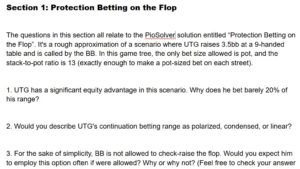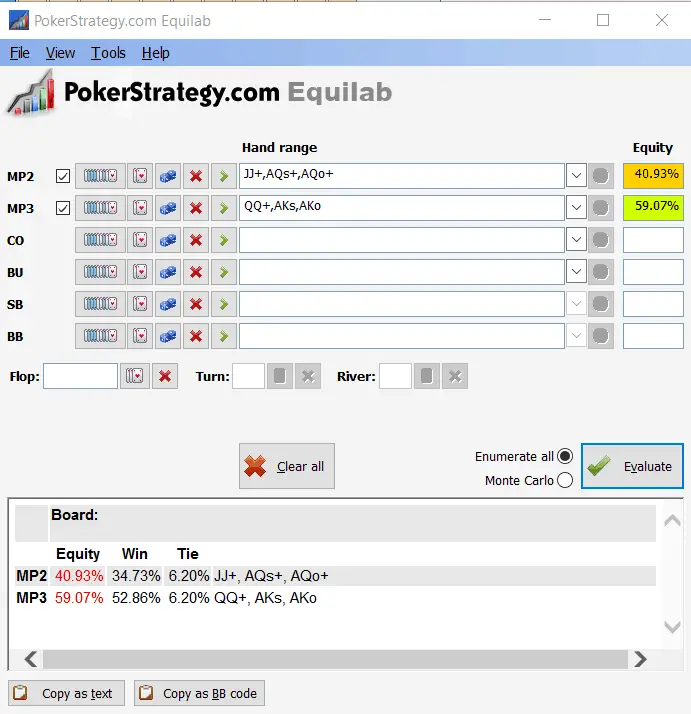- If both you and your opponent have $100 in your stack, the stack to pot ratio would be: $94: $15; SPR = 100 / 15 = 6.3; To put it another way, in this example the remaining.
- The stack to pot ratio is: 6.2 6.2 = 40 / 6.5 Depending on what blog you read or what poker book you have, you will find that there is conflicting information on what a low, medium and high SPR is. Some books will say that a low SPR is 2.5, others will say 3-4, and then others will say 6.
- Understanding Stack To Pot Ratio
- Stack To Pot Ratio Omaha
- What Is Stack To Pot Ratio
- Splitsuit Poker
- Spr Stack To Pot Ratio
- How To Measure Stock Pot
- Spr Poker
Because the identify suggests Stack to Pot Ratio (SPR) is a measure of how huge your stack is relative to the pot. We use it as a approach to decide how dedicated to you need to be to the pot. The SPR system is solely: Efficient Stack Measurement/Pot Measurement = Stack to Pot Ratio.
Understanding Stack To Pot Ratio
Stack To Pot Ratio Omaha
It's the middle stage of the tournament. You look down at in the small blind. It folds around and you open the action with a raise to twice the big blind. Your solid and aggressive opponent in the big blind calls, making the pot 4 BBs. The flop comes . What should you do?
To answer the question, you need a critical piece of information — the stack-to-pot ratio. Let's get a firm hold on using the stack-to-pot ratio (SPR) to take the best action in your next tournament.
Profitable poker is a matter of defining the best risk for the potential reward for each of your actions. Every choice you make is an opportunity to outthink and to outplay your opponent. Adding that missing bit of information in the hand, the SPR, lets you know when to hit the gas or when to pump the breaks.
Larger stack sizes demand caution, especially in tournament play when risking all of your chips means you could be in for a long walk to the parking lot. Meanwhile with shorter stacks, the value of your particular hand in a particular situation can very often tip the scales toward you wanting to be all in to win a massive portion of your stack.
Stack-to-pot ratio helps define the riskiness of actions with a particular hand. The SPR gives you a clear action in several cases. For example, with 20 big blind stacks, if you bet with on a flop and face a raise, you are holding a monster! However, if you face the same scenario with 200 big blind stacks, then you should begin to worry how that raise is going to affect the rest of the hand. Will you want to call down with one pair? Will the turn and/or river be scary for your hand? Are you already way behind what your opponent has?
Check out this quick PokerSprout video, then see if you can answer the questions at the end of the article with a firm understanding of the stack-to-pot ratio.
Back to the hand. The flop is , the pot is 4 BBs, and you have a decision, and an SPR.
1. The stacks are 20 BBs, making the SPR 5. What do you do?
Try a check-raise all in. Your opponent might bluff very often, and even if you are called, you have an excellent chance of winning. Make the last raise and you can win the pot by inducing folds as well. Also, and perhaps most importantly, when you check this type of flop in future, your opponent is going to be confused about bluffing.

2. The stacks 30 BBs, making the SPR 7.5. What do you do?
Try continuation betting with the intention of reraising all in. With an SPR of 7.5, your opponent has enough room to make a flop raise to a smaller size than an all-in. What's the worst case scenario? You get called by a great hand like a set and you still have around a 40% chance of winning! You have a great chance of picking up the pot, probably around 12 big blinds, risk-free. Boom!
3. The stacks are 70 BBs, making the SPR 17.5. What do you do?
A continuation bet makes a lot of sense for this one. If you're raised, you can call and play a lot of turns that would be scary for other hands you might want to use when you bet and call, hands like . Also, an all-in raise risks a pretty big stack. If you reraise smaller, then your opponent might put you all in, and calling off a larger stack with queen-high isn't exactly the path to victory! This way, if the turn comes a non-diamond eight, you have some very strong hands and some very weak hands that you play the same way. Nice.

Different SPRs demand different actions. Not only that, SPR paves the way to a balanced game plan that allows you to intuit a strategy extremely difficult to exploit.
If you're on top of SPR, share a comment describing a time that knowing the SPR helped make your next action very clear, and maybe even saved your tournament life.
Reid Young is lead instructor at PokerSprout, an on-demand video education service where bite-sized and laser-focused videos turbo charge your poker strategy quickly and efficiently. Start your free trial today at PokerSprout.com and experience a better way to learn poker strategy.
Want to stay atop all the latest in the poker world? If so, make sure to get PokerNews updates on your social media outlets. Follow us on Twitter and find us on both Facebook and Google+!
Tags
tournament strategyno-limit hold’emstack-to-pot ratiopostflop strategypreflop strategystarting hand selectioncontinuation bettingaggressionbluffingReid YoungPokerSprout
Note: What follows is an edited excerpt from Advanced Pot-Limit Omaha Volume I: Small Ball and Short-Handed Play.
In Professional No-Limit Hold’em, authors Matt Flynn, Sunny Mehta, and Ed Miller introduced the stack-to-pot ratio (SPR), which is simply the ratio of the effective stacks to the current size of the pot. For example, if you have a $1,000 remaining stack and there is $100 in the pot, then your SPR is $1,000/$100 or simply 10. Alternatively, let’s say there’s $100 in the pot, you have a $1,000 stack (for an SPR of 10) and are heads up with an opponent who only has a $300 stack (for an SPR of $300/$100 or 3); in this case, the effective SPR is the SPR of the smaller stack — which is 3 — because the size of the smaller stack is all that you are playing for.
As it happens, the SPR is a quite useful tool for thinking about pot-limit Omaha (PLO). In fact, the SPR is perhaps an even more useful concept for pot-limit Omaha than no limit hold’em due to the bet-size restrictions of pot-limit play, as well as the relatively standard (pot-sized) bet sizing used in PLO; both of these aspects serve to make the application of the SPR more rigid.
What Does SPR Actually Mean?
So what does SPR actually mean to us, and how do we use it?
The first thing you need to know is that an SPR of 1 means that there is one pot-sized bet left; an SPR of 4 means there is enough left for two pot-sized bets heads-up or a pot-sized bet and a pot-sized raise; an SPR of 13 is the equivalent of three pot-sized bets heads-up.
In other words, if there is $100 in the pot on the flop and we have $100 effective stacks, then there is enough money left to make exactly one pot-sized bet. If instead we have $400 stacks, then there is enough to make $100 pot-sized bet and a pot-sized raise to $400; alternatively, if we make a pot-sized bet on the flop and get one caller, then we have enough to make second pot-sized bet ($300) on the turn all-in. Meanwhile, if we have $1,300 stacks, there is enough money left to make a $100 pot-sized bet, a pot-sized raise to $400, and a pot-sized reraise all-in for $1,300 total; this is also enough to bet the pot on the flop and get a single caller, bet the pot on the turn and get called again, and then make one last pot-sized bet on the river all-in.
Note that if the effective SPR is over 13 and only two players contest the pot after the flop, the only way for all the money to go in is if somebody puts in a raise at some point in the hand.
With that in mind, we’ll categorize an SPR < 1 to be an ultra-low SPR situation, and an SPR < 4 to be a low-SPR situation. We will also categorize an SPR between 4 and 13 as a mid-SPR situation, and an SPR > 13 as a high-SPR situation. The distinction is important, because as we will see, SPR has a dramatic effect on post-flop playing decisions.
PLO Tip: When the effective SPR is over 13 and only two players put money in the pot after the flop, the only way for all the money to go in is if somebody puts in a raise at some point in the hand.
High SPR Situations (SPR > 13): Big Pot Hands vs. Small Pot Hands

When the SPR is greater than 13, there are more than 3 pot-sized bets left to play, and you are in a high SPR situation and are in Big Play (Implied Odds) Territory. And when the stacks are this deep, it is most crucial to distinguish between big-pot and small-pot hands.
In my first book Pot-Limit Omaha Poker: The Big Play Strategy, the main focus was on the hands that are capable of winning the big pots, namely the nut straight with re-draws, the overfull (such as A-A-x-x on a A-K-K flop, or A-K-x-x on a A-A-K flop), top set (especially with re-draws), the nut flush, and dominating draws (such as the 16-card nut wrap on a rainbow flop, top pair and a 13-card nut wrap on a rainbow flop, or any of the above combined with a flush draw). These hands are universally strong in that they tend to do well no matter how deep you are.
In other words, you will be about as comfortable putting four bets in on the flop with these hands as you will one. And so generally speaking, you will ram and jam with these hands in an effort to get the money all-in on the flop against any amount of action.

Big Pot Hands: High SPR/Universal Hands
| The nut straight with re-draws |
| The overfull (A-A-x-x on A-x-x board, or A-K-x-x on A-A-K board) |
| Top set for the nuts (especially with re-draws) |
| The nut flush |
| Dominating draws |
But what do you do in a high-SPR situation when you aren’t that strong?
Let’s say it’s a $5-$5 game. There are five players and $25 in the pot on the flop, and everybody has $1,000 stacks for an SPR of 40, which equates to four pot-sized bets. You are last to act. The first player leads out with a $25 bet, and everybody folds to you.

What Is Stack To Pot Ratio
As you know from our previous study it would be a disaster to commit your stack on the flop here with hands like the bare nut straight with no re-draws, the underfull (as in A-7-x-x on a A-7-7 flop or 7-7-x-x on a A-A-7 flop), middle set or bottom set, bare top two pair, undertrips (as in 8-7-6-5 on a Q-7-7 board), the second-nut flush, or a sucker wrap or draw. Because with an SPR of 40, it would take four pot-sized bets in order to get all-in heads up on the flop (your opponent bets $25, you make a pot-sized raise to $100, your opponent re-raises the max to $325, and you re-raise the max to $1,000 total).
Splitsuit Poker
Now this might seem obvious, but there are only three betting rounds after the flop in Omaha (the flop, the turn, and the river). And so, as noted earlier, the only way a fourth bet can physically go in is if somebody at some point in the hand puts in a raise. In this case, with your opponent leading the betting, it is probably going to have to be you. But sitting this deep, you are going to have trouble finding opponents who are willing to stick four bets in on the flop with a hand worse than yours. And so as a general rule, you should basically never (if ever) raise with any of these small-favorite/big-dog holdings when the SPR > 13; in fact, unless you are on a stone bluff (and can justify it), you should tend to refrain from raising on the flop in this spot at all unless you have a hand with which you actually want to put a fourth bet in of any kind.
Small Pot/Low SPR Hands
Spr Stack To Pot Ratio
| The bare nut straight |
| The underfull |
| Middle or bottom set |
| Undertrips (i.e. 8-7-6-5 on A-7-7 flop) |
| The second-nut flush |
| Big non-nut wraps |
How To Measure Stock Pot
PLO Tip: When the SPR > 13 (there are more than three pot-sized bets left to play), you should tend to refrain from raising on the flop unless you have a hand strong enough to justify putting in a fourth bet; this generally means smooth-calling on the flop with small-pot hands when facing a bet.
Spr Poker
Jeff Hwang is a gaming industry consultant and author of Pot-Limit Omaha Poker: The Big Play Strategy and the three-volume Advanced Pot-Limit Omaha series.